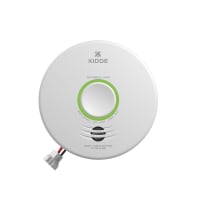Things to Look for in an CO Alarm
We recommend choosing CO alarms that have the most accurate sensing technology available. CO alarms are designed to warn you when carbon monoxide levels have begun to accumulate over a period of time, and will sound before most people would experience any CO poisoning symptoms. The more accurate the alarm, the greater chance you and your family have of responding appropriately to the problem.
Electrochemical sensor
Alarms with electrochemical sensors are more stable during humidity and temperature changes and resist reacting to common household chemicals that may cause false readings. Kidde's CO alarms include Nighthawk™ technology, which has been proven to be the world's most accurate carbon monoxide-sensing technology based on claims by major manufacturers.
CSA-listed
CO alarms should meet the strict third-party standards set by the Canadian Standards Association (CSA). Look for the CSA and Blueflame 6.19-01 marks. These guarantee the CO alarm meets all the latest and required Canadian safety standards.
Additional Considerations
Digital Display: A digital display screen clearly shows the level of CO detected in the home, and updates the reading every 15 seconds.
Peak-Level Memory: This feature records the highest level of CO present. Knowing the CO level in the home can help emergency personnel determine treatment.
Plug-in with Battery Backup: Easy to plug into any electrical socket, these alarms include a 9V battery for protection during short-term power outages.
Battery-Operated: Consumers who live in areas prone to power outages or who own a gas-powered generator should consider a battery-powered CO alarm with a backlit digital display. Battery-powered units offer 24-hour-a-day CO monitoring when power is interrupted. The backlit digital display allows the user to view the CO level in the dark. The alarm can also be placed on a shelf or wall or moved from room to room.
Voice Warning: This feature clearly announces the threat present in the home, in addition to emitting the traditional alarm beep. It is often a feature of combination smoke/CO alarms.
Placement & Maintenance
So you’ve selected the right solutions for your home. Now comes the important part: knowing where to place them and how to properly maintain them. Kidde can help.
-
Install at least one CO alarm on every floor and in sleeping areas.
-
Make sure CO alarms are at least 15 feet away from cooking or heating appliances to prevent false alarms.
-
Don't cover or obstruct the unit. Test the CO alarm weekly.
-
Replace CO alarms every 7 to 10 years (depending on your model) to benefit from the latest technology upgrades.



